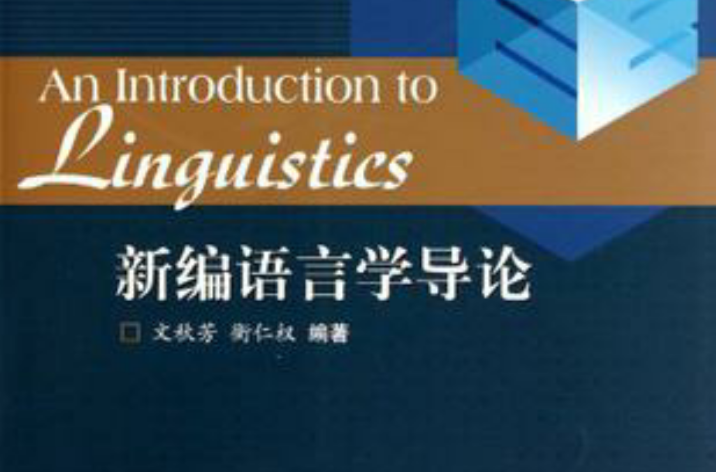內容介紹
文秋芳、衡仁權編著的《新編語言學導論》全書分為三部分。第一部
分語言體系(Language system),第二部分語言運用(Language use),
第三部分語言學習(Language learning)。全書用英文撰寫,行文流暢。
簡明易懂,概念明確,例證豐富。每個章節後面附有總結(Summary)、學
習建議(Suggestions for study)、練習(Questions and exercises)
與小型研究課題(Mini—research project),便於教師組織教學,也方
便讀者自學。《新編語言學導論》可作為英語專業本科學生的教材,也可
作為碩士研究生的輔助讀本。
作者介紹
文秋芳:北京外國語大學中國外語教育研究中心主任,教授,博士生導師,中國英語教學研究會會長。1985年獲印度孟買大學碩士學位,1993年獲香港大學博士學位;曾在南京師範大學和南京大學任教。研究領域為套用語言學,研究興趣包括二語習得、學習策略、口語測試、語料庫研究等。
衡仁權,蘇州大學副教授、碩士生導師、博士。近年來在《外語教學與研究》、《外語界》等刊物發表論文多篇;出版專著《英語專業學生口語中動詞語法型式使用研究》;參編《英語語法實用教程》,《讀寫教程》等教材。
作品目錄
Introduction 1 1 Linguistics and English linguistics 2 Structure of the book 2 Part I Language System Overview 3Chapter One What Is Language? 5 1.1 The nature of language 5 1.1.1 Defininglanguage 5 1.1.2 The design features of language 6 1.2 Distinctions between important concept pairs in linguistic study 10 1.2.1 Synchronic and diachronic 10 1.2.2 Langue and parole 11 1.2.3 Competence and performance 11 1.2.4 Syntagmatic and paradigmatic 11 Summary 12 Suggestions for study 13 Questions and exercises 13 Mini-research project 14ChapterTwo Phonetics 15 2.1 Speech organs 15 2.2 Consonants and vowels 16 2.2.1 The International Phonetic Alphabet 16 2.2.2 Describing the English consonants 17 2.2.3 Describing the English vowels 23 Summary 25 Suggestions for study 26 Questions and exercises 26 Mini-research project 28Chapter Three Phonology 29 3.1 Important concepts in phonology 29 3.1.1 Phonemes 29 3.1.2 Minimal pairs and sets 30 3.1.3 Phonemes, phones and allophones 30 3.2 Identifying phonemes 32 3.2.1 Environment and distribution 32 3.2.2 Three types of distribution 33 3.3 Sequences of phonemes 35 3.4 Co-articulation effects 36 3.4.1 Assimilation 36 3.4.2 Elision 37 3.5 Supra-segmental features 37 3.5.1 Stress 37 3.5.2 Tone and intonation 38 3.5.3 Juncture 39 Summary 40 Suggestions for study 41 Questions and exercises 41 Mini-research project 43Chapter Four Morphology 44 4.1 What is morphology? 44 4.2 Morphemes 45 4.3 Classifications of morphemes 46 4.3.1 Roots and affixes 46 4.3.2 Free morphemes and bound morphemes 47 4.3.3 Prefixes, suffixes and infixes 48 4.3.4 Inflectional and derivational affixes 48 4.3.5 Root, base, and stem 50 4.4 Morphemes, morphs and allomorphs 51 4.5 Empty morph and zero morph 52 4.6 Morphemic analysis 54 4.7 The role of morphology in English 57 4.7.1 Grammatical functions of inflectional morphology 57 4.7.2 Derivational morphology and word-formation processes 57 Summary 62 Suggestions for study 63 Questions and exercises 64 Mini-research project 66Chapter Five Syntax 67 5.1 Structural description of sentences 67 5.1.1 Syntactic relations 67 5.1.1.1 Sequential (syntagmatic) relations 67 5.1.1.2 Substitutional (paradigmatic) relations 68 5.1.1.3 Hierarchical relations 69 5.1.2 Labeled IC analysis and the hierarchical structuring of English sentences 71 5.2 Generation of sentences 74 5.2.1 Surface structure and deep structure 74 5.2.2 A general description of phrase structure rules (PS rules) 77 5.2.2.1 Noun phrases and adjective phrases 78 5.2.2.2 Verb phrases and auxiliary phrases 78 5.2.3 Transformational rules 82 5.2.3.1 T-Affix 83 5.2.3.2 Passivization 84 Summary 86 Suggestions for study 87 Questions and exercises 88 Mini-research project 90Chapter Six Semantics 91 6.1 What is meaning? 91 6.2 Lexical semantics 93 6.2.1 Componential analysis 93 6.2.1.1 What is componential analysis? 93 6.2.1.2 General and specific semantic features 94 6.2.1.3 Redundant semantic features 94 6.2.1.4 Semantic classes 95 6.2.2 Semantic field 95 6.2.2.1 What is a semantic field? 95 6.2.2.2 Sense relationships 96 6.2.3 Lexical ambiguity 100 6.2.3.1 Polysemy 100 6.2.3.2 Homonymy 100 6.2.4 Collocations in English 101 6.3 Sentence semantics 102 6.3.1 What is essential for determining sentence meaning? 103 6.3.2 Semantic roles 104 6.3.3 Grammatical functions and semantic roles 106 6.3.4 Semantic anomaly 107 Summary 108 Suggestions for study 109 Questions and exercises 110 Mini-research project 114 Part II Language Use Overview 115Chapter Seven General Principles of Communication 117 7.1 The Cooperative Principle 117 7. t.1 The four maxims of the Cooperative Principle 118 7.1.2 Violation of the maxims and conversational implicature 120 7.2 The Politeness Principle 123 7.3 The Principle of Relevance 125 7.3.1 The basic principle 125 7.3.2 Contextual effects and processing effort 126 7.3.3 Optimal relevance 127 Summary 128 Suggestions for study 129 Questions and exercises 130 Mini-research project 131Chapter Eight Intercultural Communication 132 8.1 Important concepts 132 8.1.1 What is culture? 132 8.1.2 What is communication? 134 8.1.3 What is intercultural communication? 134 8.2 Language and culture 135 8.2.1 The impact of language on culture 136 8.2.2 The impact of culture on language 137 8.2.2.1 Impact at the lexicallevel 137 8.2.2.2 Impact at the discourse level 137 8.3 Diverse intercultural communication patterns 138 8.3.1 Low-context and high-context communication 138 8.3.2 Direct and indirect verbal communication 140 8.3.3 Person-oriented and status-oriented verbal communication 141 8.3.4 Self-enhancement and self-effacement communication 141 8.4 Potential problems in intercultural communication 142 8.4.1 Seeking similarities 142 8.4.2 Stereotyping 143 8.4.3 Prejudice 144 8.4.4 Ethnocentrism 144 8.4.5 Culture shock 145 Summary 146 Suggestions for study 147 Questions and exercises 148 Mini-research project 150Chapter Nine Language Variety 151 9.1 Language--dialect--regional dialect--social dialect 152 9.1.1 Language and dialect 152 9.1.2 Regional dialects 152 9.1.3 Social dialects 153 9.2 Lingua franca--pidgin--creole 154 9.2.1 Lingua franca 154 9.2.2 Pidgin 154 9.2.3 Creole 155 9.3 Style--genre--taboo--euphemism 155 9.3.1 Style 155 9.3.2 Genre 157 9.3.3 Taboo 158 9.3.4 Euphemism 159 9.4 Gender and language use 160 Summary 161 Suggestions for study 162 Questions and exercises 162 Mini-research project 163 Part III Language Learning Overview 165Chapter Ten Major Issues in SLA 167 10.1 Contrastive Analysis Hypothesis 167 10.2 Error Analysis 168 10.3 The Interlanguage Hypothesis 170 10.4 The Monitor Model 171 10.5 The Output Hypothesis 173 10.6 The Open-Choice Principle and the Idiom Principle 174 Summary 176 Suggestions for study 177 Questions and exercises 177 Mini-research project 178Chapter Eleven Factors Affecting Second Language Learning 179 11.1 Factors not easily modified by learners 179 11.1.1 Anxiety 179 11.1.2 Inhibition and risk-taking 180 11.1.3 Extroversion/Introversion 181 11.2 Factors easily modified by learners 183 11.2.1 Motivation and attitudes 183 11.2.2 Self-esteem 184 11.2.3 Learner strategies 185 11.2.3.1 Language learning strategies 185 11.2.3.2 Language use strategies 186 11.2.3.3 Differences between effective and ineffective learners 188 Summary 197 Suggestions for study 198 Questions and exercises 198 Mini-research project 199Chapter Twelve Developing an Intercultural Communicative Competence 200 12.1 A brief review of current models of second language competence 200 12.2 Why are current models inadequate? 201 12.3 A model of intercultural communicative competence 204 12.4 Intercultural competence in communicative language use 205 Summary 207 Suggestions for study 208 Questions and exercises 208 Mini-research project 209 References 210

